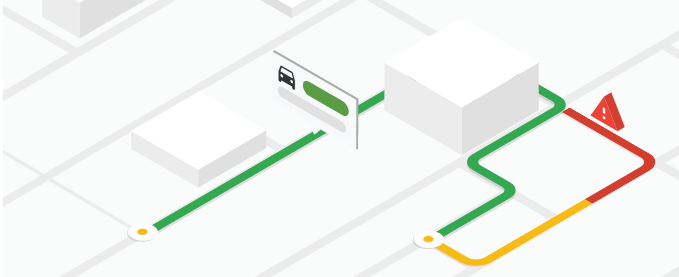
Directions API'yi neden kullanmalısınız?
Directions API ile toplu taşıma, araba, yaya veya bisiklet gibi çeşitli ulaşım modları için yol tarifi alabilirsiniz.
Directions API ile neler yapabilirsiniz?
Directions API ile konumlar arası yol tariflerini aşağıdaki ayrıntılar dahil olmak üzere hesaplayabilirsiniz:
- Toplu taşıma, araba, yaya veya bisiklet gibi çeşitli ulaşım yöntemleri için yol tarifleri.
- Bir dizi ara nokta kullanarak çok parçalı yol tarifleri.
- Başlangıç noktalarını, varış noktalarını ve geçiş noktalarını metin dizeleri (örneğin, "Chicago, IL" veya "Darwin, NT, Avustralya"), yer kimlikleri veya enlem/boylam koordinatları dahil olmak üzere birden fazla şekilde belirtin.
Directions API'nin işleyiş şekli
Yol Tarifi API'si yol tarifi hesaplamalarında en verimli rotaları döndürür. Ürün, en verimli rotayı belirlerken aşağıdaki seyahat unsurlarını hesaba katar:
- Seyahat süresi (birincil)
- Mesafe
- Dönüş sayısı
Aşağıdaki örnek istek, Ontario, Toronto'dan Quebec, Montreal'e JSON biçiminde sürüş yol tarifleri döndürür:
https://maps.googleapis.com/maps/api/directions/json ?destination=Montreal &origin=Toronto &key=YOUR_API_KEY
Kaynaklar
Aşağıdaki tabloda, Directions API aracılığıyla kullanılabilen kaynaklar ve döndürdüğü veriler özetlenmektedir.
| Veri kaynakları | Döndürülen veriler | Dönüş biçimi |
|---|---|---|
| Yol tarifi
Yer kimlikleri, adresler veya enlem/boylam koordinatları biçiminde tedarik kaynakları ve hedefler sağlayın. Ayrıntılar için gerekli parametreler konusuna bakın. |
Rotalara, ayaklara ve adımlara ayrılmış ayrıntılı yol tarifleri. Ayrıntılar için Yol tarifi yanıtları bölümüne bakın. |
|
Directions API'yi kullanma
| 1 | Ayarları yapın. | Google Cloud projenizi oluşturarak başlayın ve kurulum talimatlarını tamamlayın. |
| 2 | Demoyu deneyin | API anahtarınız ve denemek istediğiniz bir bulut projeniz olduğunda, yol tarifi demosunu ücretsiz olarak deneyebilirsiniz. Directions API demosunu inceleyin. |
| 3 | İstek oluşturma | Örnek isteklere göz atın ve seyahat modları, ara noktalar ve rota kısıtlamaları gibi kullanabileceğiniz seçenekler hakkında bilgi edinin. Yol tarifi örneklerine bakın. |
| 4 | Yanıtlarla ilgili temel bilgileri öğrenme | Uygulamanızda yol tarifi verilerini kullanmaya hazırlanmak için veri yanıtlarını inceleyin. Ayrıntılar için Yol tarifi yanıtları bölümüne bakın. |
| 5 | Yön verilerini kendi uygulamanıza dahil edin. | Bu verileri kullanarak seyahat mesafesini ve süresini hesaplayabilirsiniz. |
Kullanılabilir istemci kitaplıkları
Bu API'yi aşağıdaki istemci kitaplıklarından birini kullanarak tercih ettiğiniz dilde çağırın:
- Google Haritalar Hizmetleri için Java istemcisi
- Google Haritalar Hizmetleri için Python istemcisi
- Google Haritalar Hizmetleri için Go İstemcisi
- Google Haritalar Hizmetleri için Node.js istemcisi
Google Haritalar Hizmetleri için Java İstemcisi, Python İstemcisi, Go İstemcisi ve Node.js İstemcisi, Apache 2.0 Lisansı kapsamında açık kaynaklı olarak sunulan ve topluluk tarafından desteklenen istemci kitaplıklarıdır. Bu kitaplıkları GitHub'dan indirebilirsiniz. GitHub'da kurulum talimatlarını ve örnek kodu da bulabilirsiniz.
Sırada ne var?
- Directions API'yi kullanmaya başlama: Başlayın bölümüne gidin.
- Yol tarifi istekleri göndermeye başlama: Yol tarifi alma bölümüne gidin.
- En iyi uygulamaları takip edin: Web hizmetiyle ilgili en iyi uygulamalar başlıklı makaleyi inceleyin.

